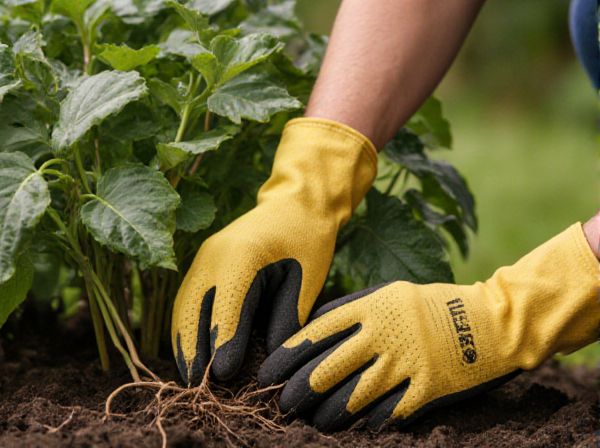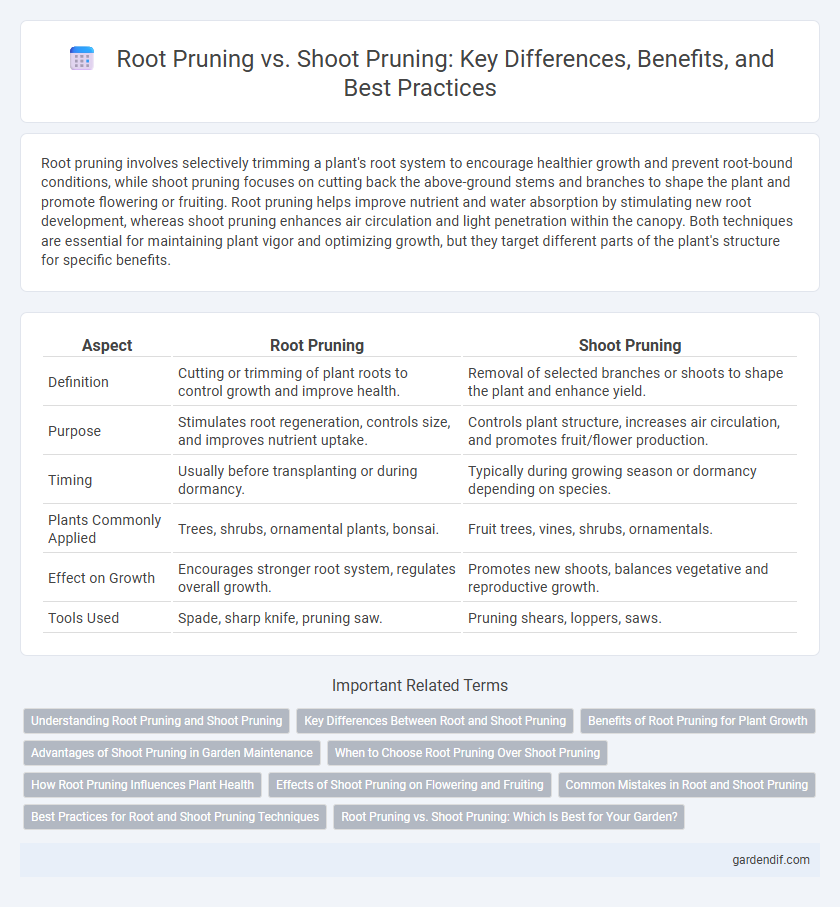
Root pruning vs Shoot pruning Illustration
Root pruning involves selectively trimming a plant's root system to encourage healthier growth and prevent root-bound conditions, while shoot pruning focuses on cutting back the above-ground stems and branches to shape the plant and promote flowering or fruiting. Root pruning helps improve nutrient and water absorption by stimulating new root development, whereas shoot pruning enhances air circulation and light penetration within the canopy. Both techniques are essential for maintaining plant vigor and optimizing growth, but they target different parts of the plant's structure for specific benefits.
Table of Comparison
| Aspect | Root Pruning | Shoot Pruning |
|---|---|---|
| Definition | Cutting or trimming of plant roots to control growth and improve health. | Removal of selected branches or shoots to shape the plant and enhance yield. |
| Purpose | Stimulates root regeneration, controls size, and improves nutrient uptake. | Controls plant structure, increases air circulation, and promotes fruit/flower production. |
| Timing | Usually before transplanting or during dormancy. | Typically during growing season or dormancy depending on species. |
| Plants Commonly Applied | Trees, shrubs, ornamental plants, bonsai. | Fruit trees, vines, shrubs, ornamentals. |
| Effect on Growth | Encourages stronger root system, regulates overall growth. | Promotes new shoots, balances vegetative and reproductive growth. |
| Tools Used | Spade, sharp knife, pruning saw. | Pruning shears, loppers, saws. |
Understanding Root Pruning and Shoot Pruning
Root pruning involves selectively cutting roots to stimulate growth and improve plant health by enhancing nutrient absorption and promoting a balanced root-to-shoot ratio. Shoot pruning focuses on trimming above-ground parts such as branches and leaves to control shape, encourage flowering, and increase fruit yield. Both techniques play critical roles in managing plant development and optimizing overall growth.
Key Differences Between Root and Shoot Pruning
Root pruning involves trimming or cutting the roots of a plant to control growth and enhance root health, while shoot pruning targets the above-ground parts like branches and leaves to shape the plant and promote flowering. Root pruning primarily affects nutrient and water uptake efficiency, whereas shoot pruning influences photosynthesis and overall plant structure. Both methods require specific timing and techniques to avoid stress and ensure optimal plant development.
Benefits of Root Pruning for Plant Growth
Root pruning enhances nutrient uptake by stimulating new root growth, which improves overall plant health and vigor. This practice increases root density and oxygen availability, leading to better water absorption and resistance to drought. Root pruning also controls root size, preventing plants from becoming root-bound and promoting balanced shoot and root development.
Advantages of Shoot Pruning in Garden Maintenance
Shoot pruning promotes healthier plant growth by stimulating new shoots and improving air circulation, which reduces the risk of fungal diseases in garden plants. It enhances the aesthetic appeal of shrubs and trees by maintaining desired shapes and sizes without causing significant stress to the plant's root system. Compared to root pruning, shoot pruning is less invasive and allows for quicker recovery, making it a practical choice for regular garden maintenance.
When to Choose Root Pruning Over Shoot Pruning
Root pruning is preferable when managing plant size in confined spaces or during transplanting to minimize shock and encourage healthy root development. It is especially beneficial in container gardening or bonsai cultivation where root growth must be controlled without severely impacting above-ground growth. Choosing root pruning over shoot pruning is ideal when the goal is to stimulate root vigor and improve nutrient uptake rather than simply shaping or controlling the plant's branches.
How Root Pruning Influences Plant Health
Root pruning stimulates the growth of new, healthy roots by removing damaged or overly dense root sections, enhancing nutrient and water uptake efficiency. This process improves overall plant stability and resilience to drought and disease by promoting a more robust root system. Controlled root pruning helps balance root-to-shoot ratio, preventing excessive foliage growth that can stress the plant.
Effects of Shoot Pruning on Flowering and Fruiting
Shoot pruning significantly influences flowering and fruiting by redirecting the plant's energy from excessive vegetative growth toward reproductive development. This practice enhances light penetration and air circulation within the canopy, promoting healthier flower buds and increased fruit set. Consequently, shoot pruning can improve fruit size, quality, and overall yield by optimizing the balance between vegetative and reproductive growth.
Common Mistakes in Root and Shoot Pruning
Common mistakes in root pruning include cutting too many roots at once, which can severely stress the plant and inhibit nutrient uptake, and failing to use sterilized tools, increasing the risk of disease. Shoot pruning errors often involve removing excessive foliage, which reduces photosynthesis, or improper timing, such as pruning during active growth periods, leading to poor wound healing and increased vulnerability. Both root and shoot pruning require precise cuts and attention to the plant's growth cycle to avoid long-term damage and ensure healthy development.
Best Practices for Root and Shoot Pruning Techniques
Root pruning requires careful excavation around the root zone to avoid excessive damage, followed by clean cuts to promote healthy regrowth and prevent disease. Shoot pruning involves selectively removing branches to improve air circulation and light penetration, using sharp, sterilized tools to make precise cuts just above growth nodes. Both techniques benefit from timing during dormancy or early growth stages to minimize stress and encourage robust plant development.
Root Pruning vs. Shoot Pruning: Which Is Best for Your Garden?
Root pruning targets the underground system, stimulating healthier root growth and improving nutrient uptake, while shoot pruning focuses on trimming stems and branches to shape the plant and control size. For established plants, root pruning enhances vigor and prevents root-bound stress, especially in containers or tightly packed soil, whereas shoot pruning is essential for maintaining desired aesthetics and removing damaged or diseased foliage. Choosing between root pruning and shoot pruning depends on your garden's specific needs--root pruning benefits overall plant health and stability, while shoot pruning optimizes appearance and air circulation.
Root pruning vs Shoot pruning Infographic

 gardendif.com
gardendif.com